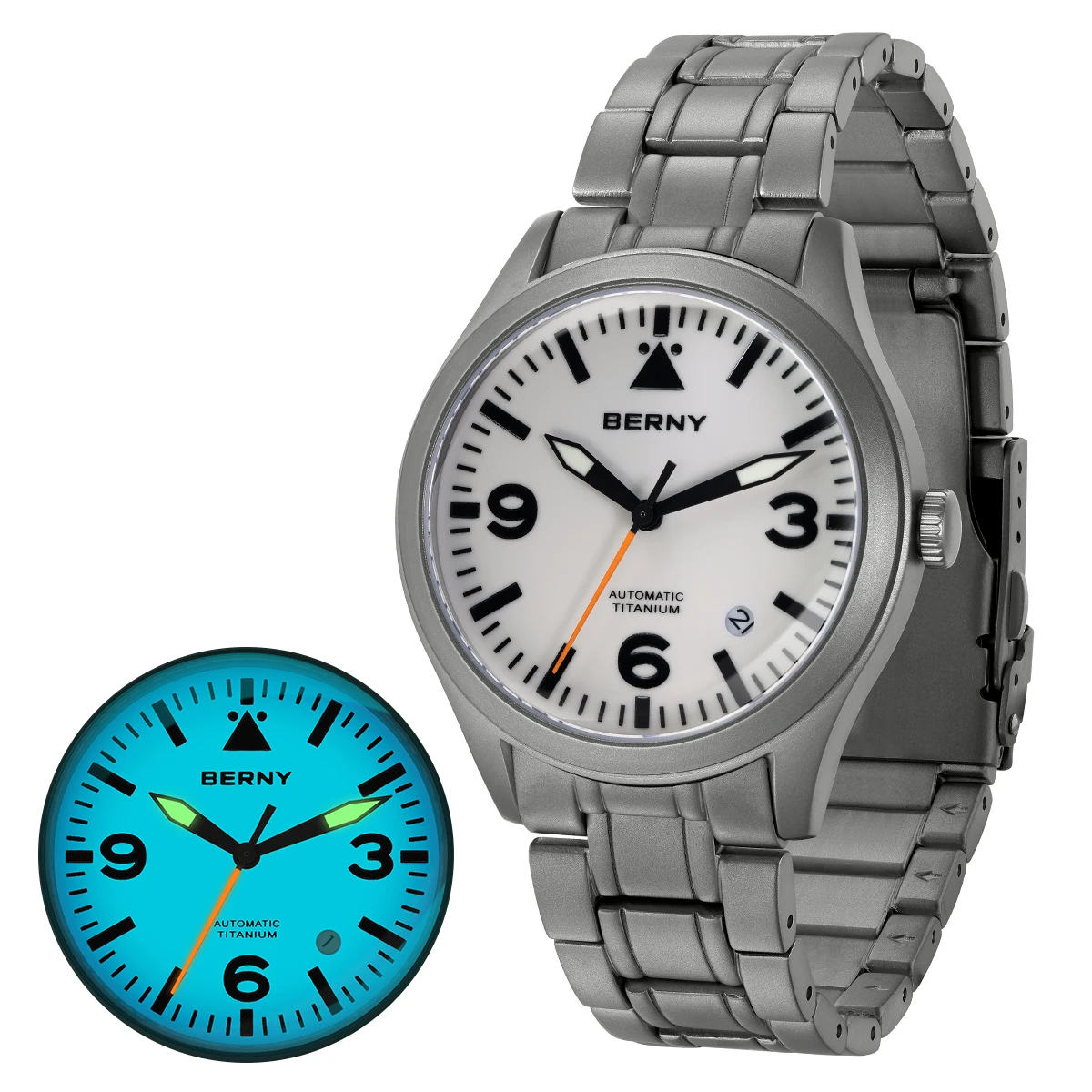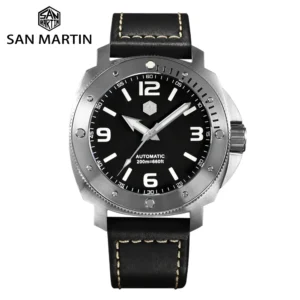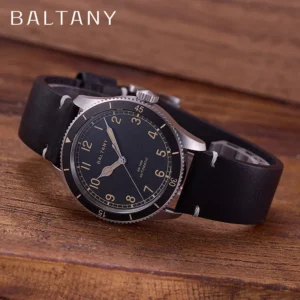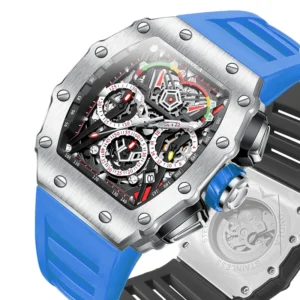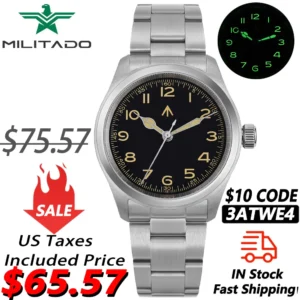What Defines a True Military Timepiece?
Military watches represent the pinnacle of functional timekeeping designed for extreme situations. Unlike standard watches focused on aesthetics or basic time display, true military timepieces are purpose-built tools engineered to perform reliably in the most demanding environments on earth.
The evolution of military watches traces back to the battlefields of early 20th century conflicts, when pocket watches proved impractical for combat. The need for quick time references without fumbling through pockets led to the adoption of wristwatches as essential equipment. Over decades, these specialized instruments transformed from simple timekeepers into sophisticated tactical tools incorporating multiple functions beyond basic timekeeping.
What truly separates military watches from civilian timepieces is their uncompromising design philosophy where function dictates form. Every element—from case construction to dial layout—directly responds to operational needs where failure could compromise missions or endanger lives. Understanding tactical elements in automatic watches provides insight into how these timepieces evolved to meet battlefield demands.
Military watches are defined by four primary feature categories: durability, legibility, reliability, and tactical functionality. Each category encompasses specific design elements engineered to ensure these watches perform flawlessly when conventional timepieces would fail.
Core Requirements That Set Military Watches Apart
Military timepieces must satisfy a set of non-negotiable requirements that separate them from ordinary watches. These core requirements aren’t about aesthetics or status—they’re about survival and operational success in environments where failure isn’t an option.
At their foundation, military watches must deliver:
- Unfailing reliability in situations where precise timing coordinates critical operations
- Consistent functionality across environmental extremes from arctic cold to desert heat
- Resistance to physical shocks, water exposure, and magnetic fields
- Instant readability in all lighting conditions from bright sunlight to complete darkness
- Extended operational life without frequent maintenance or battery changes
The importance of these requirements becomes clear when considering the contexts where these watches operate. In combat zones, synchronized operations depend on precise timing. In wilderness survival scenarios, navigation functions can mean the difference between safety and peril. Understanding what defines a tactical watch reveals how these timepieces have become essential equipment rather than mere accessories.
Military specifications formalize these requirements, establishing rigorous standards for watches intended for service use. These specifications cover everything from drop testing to water pressure resistance, ensuring every watch that earns a military designation can perform when lives depend on it.
Uncompromising Durability and Construction
Military watches are engineered from the ground up to withstand extreme physical punishment that would destroy ordinary timepieces. This exceptional durability begins with materials selection and construction techniques designed specifically for battlefield conditions.
The foundation of a military watch’s durability lies in its case construction—the protective shell that shields the delicate timekeeping mechanism inside. Cases must resist impacts, pressure, moisture, dust, and chemical exposure while maintaining structural integrity. Advanced case protection in tactical timepieces represents decades of engineering refinement to address these challenges.
Beyond physical protection, military watches incorporate sophisticated shock absorption systems to protect internal components from damage during impacts. These systems isolate the movement, preventing sudden jolts from disturbing precision components or breaking delicate parts.
Water resistance represents another critical durability factor, with military watches typically offering resistance ratings from 100 to 300 meters. This protection ensures functionality during amphibious operations, extreme weather, and unexpected water immersion.
Case Materials and Construction
The materials used in military watch cases directly determine their durability and performance in the field. Each material offers distinct advantages:
316L stainless steel: Provides excellent corrosion resistance and durability while remaining relatively affordable. Its density offers good shock protection, though at the cost of higher weight.
Titanium: Delivers an optimal strength-to-weight ratio—nearly as strong as steel but 45% lighter. Titanium automatic watches offer enhanced comfort during extended wear while providing superior corrosion resistance, especially in saltwater environments.
Composite materials: Including carbon fiber reinforced polymers and proprietary composites that deliver exceptional impact resistance while minimizing weight. These materials also provide natural insulation against temperature extremes.
Ceramic: Offers extreme scratch resistance and maintains appearance over time, though with somewhat lower impact resistance than metals.
Construction techniques further enhance durability. Many military watches feature monobloc case designs that eliminate the need for a separate case back, reducing potential entry points for water and debris. Screw-down crowns with multiple gaskets prevent water infiltration during adjustment, while reinforced lugs resist breaking when subjected to lateral force.
Shock and Impact Resistance
Military operations expose watches to impacts that would destroy standard timepieces. Combat, parachute jumps, equipment handling, and hard landings all create shocks that can damage internal mechanisms. Military watches incorporate multiple shock protection systems to maintain accuracy despite these challenges.
At the heart of these protection systems are specialized movement suspensions that isolate the delicate balance wheel and escapement from external forces. Spring-mounted jewel bearings absorb impacts while specialized elastomer cushioning systems surround sensitive components.
Military shock resistance standards are rigorous, with many watches meeting MIL-STD-810 requirements that include drop testing from specified heights onto concrete surfaces. These tests verify that watches can survive falls, impacts, and vibrations without losing accuracy or functionality.
Beyond protecting against catastrophic failure, proper shock resistance extends movement life by preventing gradual damage from accumulated minor impacts. This reliability ensures that military personnel can depend on their timepieces through extended deployments without performance degradation.
Water and Pressure Resistance
Water resistance in military watches goes far beyond splash protection, addressing complete submersion under pressure during tactical diving operations, amphibious landings, and extreme weather conditions. Understanding water resistance ratings is essential, as they often confuse consumers:
- 100m (10 ATM): Suitable for swimming and snorkeling but not for diving
- 200m (20 ATM): Appropriate for recreational scuba diving
- 300m+ (30+ ATM): Designed for professional diving operations
True military diving watches, like many professional spec dive watches, often feature helium escape valves to release pressure during saturation diving decompression. These specialized valves prevent crystal damage when pressure differentials become extreme.
Water protection systems include multiple redundant gaskets, specially designed crown tubes, pressure-tested case backs, and hydrophobic treatments. Each component undergoes individual testing before final assembly, with completed watches tested again under pressure to verify water resistance.
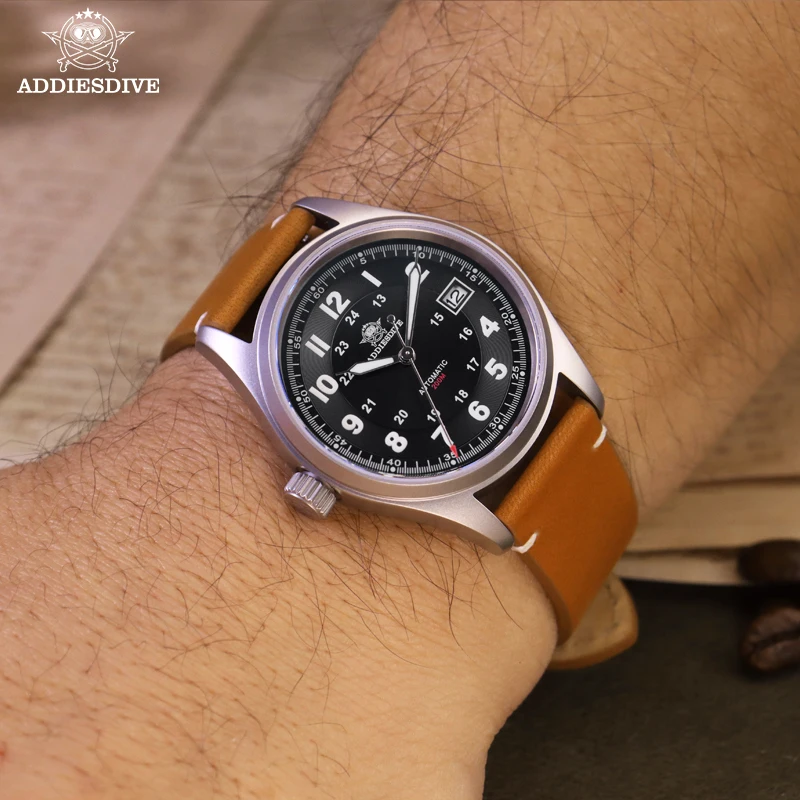
Superior Visibility and Readability
In military operations, the ability to read time instantly and accurately can be mission-critical. Military watches prioritize instant legibility under all conditions—from bright desert sunlight to complete darkness—with specialized design elements focused on rapid information access.
Unlike fashion watches that often sacrifice readability for aesthetics, military timepieces feature purposeful design where every visual element serves the primary goal of clear time communication. Understanding luminosity in tactical automatic watches reveals how these design principles evolved to ensure visibility in all environments.
This unwavering focus on readability extends to every visual aspect of the watch, from dial layout to hand design, numeral size, and contrast levels. The result is timepieces that communicate critical information with a quick glance, even in high-stress situations where split-second decisions matter.
Dial Design for Instant Readability
Military watch dials embody the principle that simplicity enhances clarity. Their design prioritizes instant comprehension through several key elements:
- High-contrast color schemes with black dials and white markings (or vice versa) maximize visibility in varying light conditions
- Large Arabic numerals that can be read at a glance without squinting or focusing
- Broader hands with distinct shapes that clearly differentiate hours from minutes
- Minimalist design that eliminates unnecessary decorative elements that could create confusion
The science behind optimizing tactical watch dial layouts involves precise spacing, proportional relationships between elements, and psychological principles of visual processing. The goal is reducing the cognitive load required to read the time, allowing the wearer to focus on the mission rather than deciphering their watch.
Military watches typically employ the 12-hour layout familiar to most users, but often include a 24-hour scale (military time) to prevent AM/PM confusion during operations. This dual-scale approach ensures compatibility with both civilian and military time references.
Low-Light and No-Light Visibility Systems
Military operations frequently occur in darkness, requiring watches to remain readable without compromising tactical concealment. Several illumination technologies address this critical requirement:
Super-LumiNova and similar photoluminescent compounds absorb light energy and release it slowly as visible glow. These materials provide 4-8 hours of gradually diminishing illumination after exposure to light, with no battery or power source required. Their brightness peaks immediately after charging and gradually fades.
Tritium gas tubes offer self-powered illumination through radioactive decay that energizes phosphor coatings. Unlike luminous paints, tritium provides consistent brightness for years without requiring light exposure to “charge.” This constant illumination makes tritium ideal for extended night operations where consistent visibility is essential.
Electronic illumination systems in digital and hybrid watches use LEDs or electroluminescent panels to provide on-demand lighting. These systems offer the brightest illumination but require battery power and manual activation, which can compromise night vision or tactical concealment if not carefully designed.
Many military watches combine these technologies, using tritium for critical markers and hands while applying Super-LumiNova to secondary elements, balancing constant visibility with peak brightness when needed.
Anti-Reflective and Tactical Considerations
Beyond being visible to the wearer, military watches must remain invisible to adversaries. Reflective surfaces can create dangerous glare that reveals position or compromises stealth, making anti-reflective treatments essential for tactical timepieces.
Crystal surfaces receive multiple layers of anti-reflective coating that eliminate flash and glare while improving transparency. Case finishes use matte, blasted, or PVD-coated surfaces that scatter rather than reflect light. Even straps incorporate non-reflective materials and subdued colors to maintain low visibility.
Color selection further enhances tactical utility, with military watches favoring earth tones, matte black, or camouflage patterns that blend with uniforms and environments. Even luminous elements may feature adjustable brightness or activation mechanisms to prevent unwanted light emission during covert operations.
These tactical considerations transform military watches from potential liabilities into assets that support mission success while minimizing detection risk—demonstrating how every aspect of design serves operational requirements.
Precision and Operational Reliability
For military timepieces, unwavering reliability isn’t a luxury—it’s a fundamental requirement. These watches must maintain precise timekeeping across extreme temperatures, altitudes, and conditions where consumer watches would fail. This reliability begins with movement selection and extends through power systems and environmental protection.
The relationship between automatic movements and tactical applications illustrates how military watches balance traditional horological principles with modern operational demands. While digital watches offer certain advantages in feature integration, mechanical watches provide critical reliability benefits, including operation without batteries and resistance to electromagnetic interference.
This focus on reliability explains why military organizations continue to issue both mechanical and quartz timepieces depending on mission requirements. Each technology offers specific advantages, with selection based on operational context, deployment duration, and functional requirements.
Chronometric Precision and Movement Types
Military watches employ several movement technologies, each offering distinct advantages:
Quartz movements provide superior accuracy (typically ±15 seconds per month) and shock resistance due to fewer moving parts. Their simplified construction makes them less susceptible to positional errors, while their affordability allows for easier replacement when damaged. However, battery dependence creates potential failure points during extended deployments.
Mechanical automatic movements offer battery-free operation through self-winding mechanisms that harness body motion. Quality automatic movements can achieve respectable accuracy (±4-6 seconds daily) while eliminating battery replacement concerns. Their fully mechanical nature provides immunity to electromagnetic pulse (EMP) effects that could disable electronic systems.
Solar-powered movements combine quartz accuracy with renewable power generation, storing energy in capacitors that can power the watch for months without light exposure. This hybrid approach eliminates battery changes while maintaining electronic precision.
Modern military watches often include temperature compensation systems that adjust timekeeping parameters as conditions change, maintaining accuracy across the -40°F to 160°F (-40°C to 71°C) temperature ranges encountered in global operations.
Power Systems and Operational Longevity
Extended deployments require power systems that deliver reliable operation without maintenance or external support. Military watches address this challenge through several approaches:
Battery-powered quartz watches designed for military use typically feature extended-life lithium cells rated for 3-10 years of continuous operation. Some incorporate battery status indicators that provide advance warning before power depletion.
Automatic mechanical watches eliminate battery concerns entirely, drawing power from the wearer’s motion through sophisticated rotor systems. Quality military automatic watches typically offer 40-80 hour power reserves, maintaining operation even during periods of inactivity.
Solar charging systems represent the ideal compromise for many applications, harvesting light energy from any source (not just sunlight) and storing it in high-capacity cells. Premium solar watches can operate for 6+ months in complete darkness after full charging.
Many tactical digital watches incorporate power management systems that monitor battery levels and automatically disable high-drain functions as power decreases, ensuring that core timekeeping functions remain operational even as battery charge diminishes.
Environmental Resilience Features
Military watches must operate flawlessly across environmental extremes that would render ordinary timepieces useless. This resilience comes through specialized protective features:
Anti-magnetic shielding protects movements from magnetic fields generated by equipment, weapons systems, and vehicles. Military-grade watches typically withstand exposure to fields of 1,000-4,000 A/m without accuracy impact, using soft iron inner cases and specialized non-ferromagnetic components.
Temperature tolerance engineering ensures consistent operation from arctic to desert environments. Special lubricants remain fluid at sub-zero temperatures while resisting breakdown under heat. Expansion-compensating materials prevent components from binding as temperatures fluctuate across extreme ranges.
The evolution of military watch styles across decades shows how these environmental protections adapted to changing battlefield conditions. Modern military watches integrate lessons from historical performance, combining traditional reliability with advanced materials science to create timepieces that withstand virtually any operational environment.
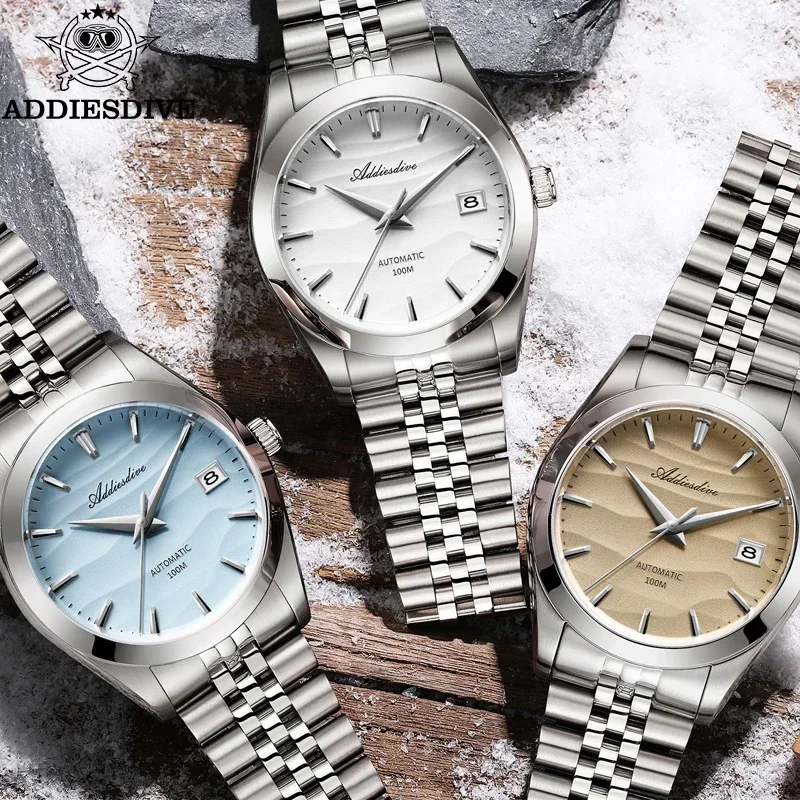
Advanced Tactical Features and Specialized Functions
Modern military watches have evolved far beyond basic timekeeping, incorporating sophisticated features that transform them into wrist-mounted tactical tools. These advanced capabilities support navigation, environmental monitoring, timing operations, and specialized mission functions.
Understanding automatic watches with tactical features reveals how traditional watchmaking merges with modern military requirements to create timepieces that serve as backup systems when primary equipment fails or becomes unavailable.
The integration of these features represents careful balance—adding functionality without compromising core reliability or creating overly complex interfaces that hinder operation under stress. Military watch designers prioritize intuitive use and clear information presentation while incorporating advanced capabilities.
Navigation and Positioning Systems
Navigation features transform military watches into backup positioning tools that support wayfinding when primary systems fail:
Digital compasses provide bearing information through magnetic sensors that detect Earth’s magnetic field. Advanced models offer declination adjustment to compensate for the difference between magnetic and true north, ensuring accurate navigation across different global regions.
GPS functionality in high-end tactical watches delivers precise positioning data, waypoint marking, and backtracking capabilities. These systems typically operate independently from smartphone connections, providing autonomous navigation support during communications blackouts or equipment failures.
Coordinate display systems allow users to reference and mark positions using various formats including MGRS (Military Grid Reference System), UTM (Universal Transverse Mercator), and traditional latitude/longitude. This versatility ensures compatibility with different mapping systems and operational standards.
These navigation systems often include track recording functions that document movement routes, allowing users to retrace paths or analyze movement patterns after mission completion.
Environmental Analysis Sensors
Environmental sensors provide tactical awareness beyond visual observation, delivering data that supports decision-making and risk assessment:
Barometric pressure sensors track atmospheric changes that indicate weather shifts, storm fronts, or altitude variations. Advanced models include trend graphs that visualize pressure changes over time, helping predict weather developments before visible signs appear.
Altimeters calculate elevation based on barometric pressure or GPS data, providing precise height information for navigation, parachuting, or mountain operations. Multi-sensor altimeters cross-reference barometric and GPS data to improve accuracy while compensating for weather-related pressure changes.
Thermometers measure ambient temperature, helping users assess environmental hazards including hypothermia or heat injury risk. Some advanced models include core temperature estimation based on wrist temperature and activity levels, providing early warning of thermal stress.
These environmental monitoring capabilities transform military watches into portable weather stations that provide tactical advantages through environmental awareness and condition forecasting.
Tactical Timing and Measurement Functions
Precision timing functions support operational coordination and specialized measurements:
Chronograph functions provide precise elapsed time measurement for mission timing, coordination of simultaneous actions, and performance assessment. Military chronographs typically feature large, easily activated pushers designed for operation while wearing gloves.
Countdown timers support timed operations, allowing precise scheduling of actions without constant time monitoring. Tactical models include vibration alerts that signal completion without audible noise that might compromise stealth.
Many tactical automatic watches incorporate tachymeter scales that convert elapsed time to speed or distance calculations. These analog computation tools provide backup capability when digital systems fail or battery power is unavailable.
Split-timing features allow intermediate time recording without stopping the main chronograph function—essential for timing multiple events or recording segment times during complex operations.
Specialized Mission-Specific Capabilities
Specialized functions address requirements for specific military roles and missions:
Maritime operations benefit from tide calculators, depth sensors, and dive logs that support underwater missions. Dedicated diving bezels provide backup decompression timing when computers fail.
Aviation-focused features include flight computers, jumpmaster functions that calculate release points, and oxygen time calculators that monitor remaining supply during high-altitude operations.
Stealth mode capabilities disable sounds, illumination, and wireless emissions to maintain tactical concealment during covert operations. Some models include night vision compatibility that ensures watch illumination doesn’t interfere with NVG equipment.
These specialized functions demonstrate how military watches have evolved from simple timekeepers into sophisticated mission support tools tailored to specific operational environments.
Military Inspired Automatic Watches, Rugged Automatic Watches, Tactical Automatic Watches
Price range: $852.14 through $994.60 Select options This product has multiple variants. The options may be chosen on the product pageBronze Automatic Watches, Military Inspired Automatic Watches, Professional Spec Dive Watches
Price range: $1,442.21 through $1,442.82 Select options This product has multiple variants. The options may be chosen on the product pageProfessional Spec Dive Watches, Titanium Automatic Watches
$574.74 Select options This product has multiple variants. The options may be chosen on the product pageClassic Pilot Watches, Military Inspired Automatic Watches
$561.00 Select options This product has multiple variants. The options may be chosen on the product pageRugged Automatic Watches, Unique Automatic Watches
Price range: $228.96 through $231.10 Select options This product has multiple variants. The options may be chosen on the product pageClassic Field Watches, Military Inspired Automatic Watches
Price range: $280.87 through $338.51 Select options This product has multiple variants. The options may be chosen on the product page
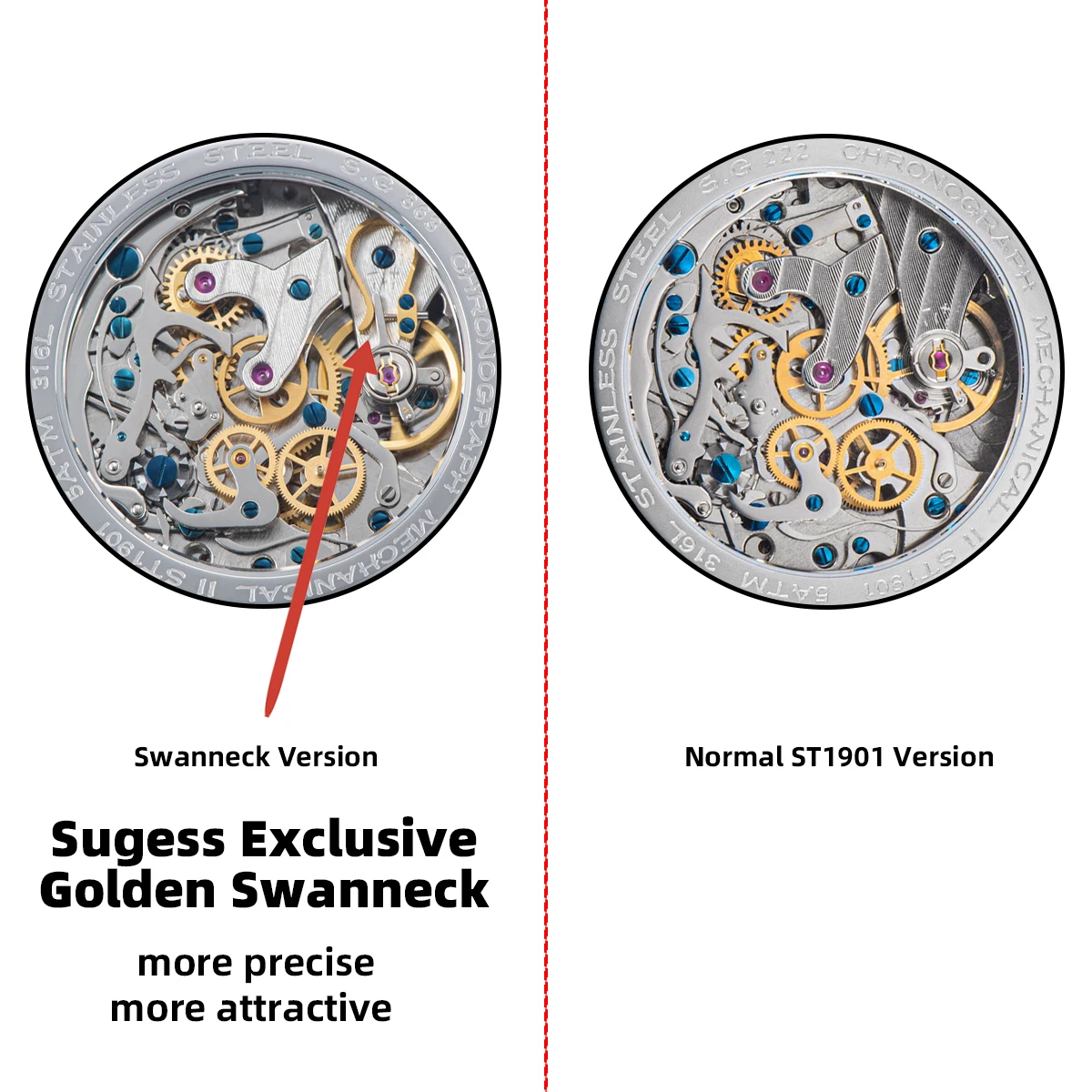
Military Specifications and Standards
Military specifications (MIL-SPEC) provide formal standards that define performance requirements for watches intended for service use. These rigorous standards transform marketing claims into verifiable requirements with specific testing protocols and minimum performance thresholds.
The most relevant specifications for military timepieces include:
MIL-PRF-46374G outlines requirements for military wristwatches, specifying water resistance (minimum 20 meters), luminosity standards (readable after 8 hours in darkness), and accuracy requirements (±30 seconds per month). This specification includes detailed testing protocols for verification.
MIL-STD-810 addresses environmental engineering considerations and laboratory tests for military equipment, including watches. It covers shock resistance, temperature extremes, humidity, sand exposure, and other environmental challenges through standardized testing procedures.
Testing under these specifications is comprehensive and punishing. Watches undergo drop tests from 1 meter onto hardwood, water pressure testing at specified depths, and thermal cycling between extreme temperatures. Additional tests include salt fog exposure, humidity cycling, and vibration testing that simulates vehicle and aircraft environments.
Understanding field-tested automatic watch designs reveals how these specifications translate into practical performance advantages. True military watches are engineered from inception to meet or exceed these standards, rather than being consumer designs retrofitted with military styling.
The distinction between authentic military-spec watches and military-inspired designs is significant. While many watches adopt military aesthetics, far fewer undergo the rigorous testing required to verify performance under genuine field conditions.
Historical Evolution of Military Timepieces
The development of military watches parallels the evolution of modern warfare, with each major conflict driving innovations that improved performance and reliability.
Early military wristwatches emerged during World War I, when officers modified pocket watches with wire lugs to create wearable timepieces that allowed time checking without removing hands from weapons. These early conversions demonstrated the tactical advantage of wrist-mounted timekeeping.
World War II accelerated development with purpose-built military watches featuring improved water resistance, luminous dials, and hack seconds functionality for precise synchronization. The famous “W.W.W.” (Wrist Watch Waterproof) specification standardized requirements across manufacturers supplying Allied forces.
The Cold War era brought further refinements including enhanced anti-magnetic protection to shield watches from electronic equipment, while the Vietnam conflict drove development of humidity-resistant seals and tropical-rated lubricants that performed in extreme heat and moisture.
Modern conflicts in diverse environments from desert to arctic regions have pushed development of multi-environment capabilities and integration with digital systems. Today’s military watches represent the culmination of over a century of battlefield-driven innovation, combining traditional reliability with cutting-edge materials and electronics.
Military Watch Features in Everyday Applications
The exceptional durability and functionality of military watches make them valuable for civilians who face demanding conditions or require absolute reliability. The features developed for battlefield use translate directly to numerous professional and recreational applications.
First responders benefit from the same readability, durability, and timing functions that make these watches valuable to military personnel. Paramedics rely on precise chronographs for medication timing, while firefighters need water and heat resistance during emergency response.
Outdoor professionals including wilderness guides, search and rescue teams, and expedition leaders depend on navigation features and environmental sensors that support decision-making in remote locations. The reliability of automatic field military watches proves particularly valuable when electronics fail in backcountry settings.
Industrial workers in construction, mining, and manufacturing environments appreciate impact resistance and readability in challenging conditions. The ability to withstand vibration, dust, and rough handling ensures consistent performance in settings that would quickly damage standard watches.
Even everyday users benefit from the extended lifespan and reduced maintenance that military-grade durability provides. The superior construction translates to watches that withstand years of daily wear while maintaining both function and appearance.
Frequently Asked Questions About Military Watches
What’s the difference between a “military watch” and a “tactical watch”?
Military watches specifically meet military specifications and are designed for armed forces use, while tactical watches incorporate similar features but may not meet formal military standards. Both emphasize durability and functionality, but military watches typically undergo more rigorous testing to verify performance under extreme conditions.
Are all authentic military watches expensive?
No. While premium military watches with advanced features can be costly, many reliable options exist at moderate price points. Basic military field watches with essential durability features are often quite affordable, while specialized models with advanced navigation or environmental sensors command higher prices reflecting their additional capabilities.
Do military personnel always get issued a standard watch?
Military issue practices vary by country and service branch. Some units issue standardized watches to all personnel, while others provide watches only for specialized roles or missions. Many service members choose to purchase personal watches that meet or exceed military requirements while offering features specific to their duties.
What does MIL-STD compliance mean for a watch?
MIL-STD compliance indicates a watch has been tested according to Military Standard procedures, typically MIL-STD-810, which covers environmental engineering considerations. This testing verifies performance under specific conditions including shock, vibration, temperature extremes, humidity, and water exposure. The ultimate guide to tactical features in automatic wristwatches explains how these standards translate to real-world performance.
How can I tell if a watch truly meets military specifications?
Authentic military-spec watches will clearly document which specific standards they meet (e.g., MIL-PRF-46374G, MIL-STD-810) and which tests they have passed. Reputable manufacturers provide this information transparently, often including test results or certification documentation. Be wary of vague claims like “military inspired” or “tactical style,” which suggest aesthetic similarity rather than performance testing.

